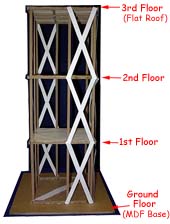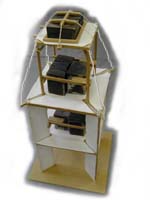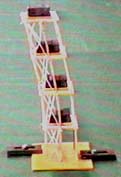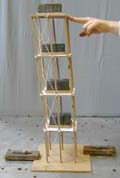
This section of the IDEERS web-site is for schools that are joining the at-Bristol Earthquake Engineering Challenge on either March 1st or March 2nd 2005. The University of Bristol's Earthquake Engineering Research Centre (EERC) and at-Bristol have challenged Year 9 students from Bristol schools to design and make small scale models of buildings that can stand up to strong earthquakes.
The Challenge
You are required to design and construct a model of a building to a scale of roughly 1:25.
Your model must:
- be made only from MDF board, paper, glue and string.

- have at least 4 floors and fit on 25 cm square base board.

- be able to carry 7.5 kilograms or more.

The model should stand up to artificial earthquakes generated on the Shaking-Table in the University of Bristol's EERC laboratory.
To find out about the rules for the at-Bristol Challenge and the artificial earthquakes, visit these pages.
- At-Bristol Material Rules (What to use for building your model)
- At-Bristol Structure Rules (How to construct your model)
- At-Bristol Vertical Load Rules (How strong your model should be)
- The Artificial Earthquakes
- Prizes
| Warning! The At-Bristol Challenge and Rules are different from the IDEERS Challenge, so make sure you read these at-Bristol pages for the correct details. |
How to make a strong model
|
Earthquakes cause sideways forces on buildings, sometimes making them sway from side to side. The forces on a building during an earthquake produce a similar effect to horizontal (or sideways) forces trying to push the building over. |
|
|
A model building swaying on the shaking-table during an artificial earthquake. |
The same model being pushed sideways by somebody. |
 |
 |
|
Notice how the model bends in the same way for both forces. |
|
You can find out how to strengthen your model to resist sideways forces by reading these pages in the IDEERS Resistant Buildings section.
Braced Frames
Moment Resisting Frames
Shear Walls
Horizontal Trussing
Horizontal Diaphragms
To get hints for making your model, read these pages in the IDEERS Competition section
Modelling Techniques (Construction Tips)
Strengthening Your Model (Hints on bracing)
Model Gallery (Designs by others)